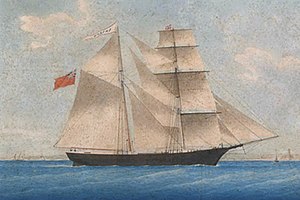
Back ماري سليست Arabic Meri Selest Azerbaijani Мария Селесте Bulgarian ম্যারি সেলেস্ট Bengali/Bangla Mary Celeste Catalan ماری سلێست CKB Mary Celeste Czech Mary Celeste German Μαίρη Σελέστ Greek Mary Celeste Spanish
 An 1861 painting of Mary Celeste (named Amazon at the time) by an unknown artist
| |
| History | |
|---|---|
| Name | Amazon |
| Port of registry | Parrsboro, Nova Scotia |
| Builder | Joshua Dewis, Spencer's Island, Nova Scotia |
| Launched | May 18, 1861 |
| Fate | Ran aground Glace Bay, Nova Scotia, 1867, salvaged and given to American owners |
| Name |
|
| Port of registry | Principally New York or Boston |
| Builder | Rebuilt 1872, New York (yard not named) |
| Fate | Deliberately wrecked off the coast of Haiti, 1885 |
| General characteristics | |
| Tonnage |
|
| Length | 99.3 ft (30.3 m) as built, 103 ft (31 m) after rebuild |
| Beam | 22.5 ft (6.9 m) as built, 25.7 ft (7.8 m) after rebuild |
| Depth | 11.7 ft (3.6 m) as built, 16.2 ft (4.9 m) after rebuild |
| Decks | 1, as built, 2 after rebuild |
| Sail plan | Brigantine |
Mary Celeste (/səˈlɛst/; often erroneously referred to as Marie Celeste[1]) was a Canadian-built, American-registered merchant brigantine that was discovered adrift and deserted in the Atlantic Ocean off the Azorean islands on December 4, 1872. The Canadian brigantine Dei Gratia found her in a dishevelled but seaworthy condition under partial sail and with her lifeboat missing. The last entry in her log was dated ten days earlier. She had left New York City for Genoa on November 7 and was still amply provisioned when found. Her cargo of alcohol was intact, and the captain's and crew's personal belongings were undisturbed. None of those who had been on board were ever seen or heard from again.
Mary Celeste was built in Spencer's Island, Nova Scotia, and launched under British registration as Amazon in 1861. She was transferred to American ownership and registration in 1868, when she acquired her new name. Thereafter she sailed uneventfully until her 1872 voyage. At the salvage hearings in Gibraltar following her recovery, the court's officers considered various possibilities of foul play, including mutiny by Mary Celeste's crew, piracy by the Dei Gratia crew or others, and conspiracy to carry out insurance or salvage fraud. No convincing evidence supported these theories, but unresolved suspicions led to a relatively low salvage award.
The inconclusive nature of the hearings fostered continued speculation as to what had happened to the ship's occupants, and the story has repeatedly been complicated by false detail and fantasy. Hypotheses that have been advanced include the effects on the crew of alcohol fumes rising from the cargo, submarine earthquakes, waterspouts, attack by a giant squid, and paranormal intervention.
After the Gibraltar hearings, Mary Celeste continued in service under new owners. In 1885, her captain deliberately wrecked her off the coast of Haiti as part of an attempted insurance fraud. The story of her 1872 abandonment has been recounted and dramatized many times in documentaries, novels, plays, and films, and the name of the ship has become a byword for unexplained desertion. In 1884, Arthur Conan Doyle wrote "J. Habakuk Jephson's Statement", a short story based on the mystery, but spelled the vessel's name as Marie Celeste. The story's popularity led to the spelling becoming more common than the original in everyday use.
- ^ Oxford University Press (2021). "Mary Celeste (proper noun)". Lexico.com. Dictionary.com. Archived from the original on January 9, 2021. Retrieved January 5, 2021.